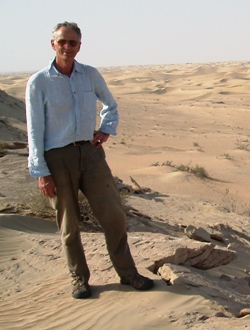 BGS geologist, journal editor and expert on Palaeogene-Neogene stratigraphy and sedimentology
BGS geologist, journal editor and expert on Palaeogene-Neogene stratigraphy and sedimentology
Robert William O’Brien Knox was born in 1942 near Tadcaster, Yorkshire. His family moved to East Sussex when he was a baby. Robert soon became interested in natural sciences, and returned north in 1961 to study geology at King’s College Durham. He gained a first-class honours degree from the University of Newcastle in 1965 and stayed to undertake a PhD on the sedimentology of the Middle Jurassic of Yorkshire, receiving his doctorate in 1971. Robert’s first job was as a Demonstrator at the University of Cambridge between 1968 and 1973, where he taught sedimentary geology. He published his first five papers at Cambridge, and wrote the chapter on sedimentary rocks for the 1978 edition of Petrology for Students.
(Picture: Robert Knox in the desert, 2013. Photo: Andy Farrant)
A position at the British Geological Survey (BGS) became available and, in 1973, Robert was appointed as a sedimentologist. Like most specialists, he worked on a variety of projects including the Lower Jurassic Frodingham Ironstone, the Lower Cretaceous Speeton Clay, using ash beds as stratigraphical markers, Mesozoic and Cenozoic sandstones of the North Sea, and Paleogene/Neogene stratigraphy.
IMPACT
It is on Paleogene and Neogene stratigraphy where Robert made the highest scientific impact. He worked on the sedimentology of the main Paleogene sandstones of the North Sea and their onshore correlatives, and built up a peerless knowledge of these units. Together with Andy Morton, Robert also undertook developmental work in provenance studies using heavy minerals. These minerals are stratigraphical indices, and indicate the transport history and source of sandstones.
Robert became Group Manager for stratigraphy and sedimentology in BGS in 1984 and, during the late 1980s, he worked on a major study of the Middle Jurassic Ravenscar Group of northeast Yorkshire for the Institut Français du Pétrole. The UK hydrocarbons industry commissioned an independent lithostratigraphical nomenclature for the North Sea, and Robert was asked to lead this. He co-edited all seven volumes, and co-authored three, between 1992 and 1994.
The Proceedings of the Yorkshire Geological Society (PYGS) was edited by Robert between 1982 and 1990. Under his expert editorship, the reputation and scope of the PYGS was significantly enhanced. The Yorkshire Geological Society recognised this major contribution, and his contribution to the geology of northern England and the North Sea, by awarding Robert their Sorby Medal in 1997. He also served on the Geological Society Stratigraphy Commission from 1995.
HEAVY MINERALS
Robert retired in 2002 but continued to be equally committed, pursuing research on the Paleocene-Eocene Thermal Maximum, the Neogene/Quaternary stratigraphy of the United Arab Emirates, Palaeozoic heavy minerals from Arabia, and Paleocene stratigraphy. He was prodigiously productive in retirement, producing 23 of his 94 contributions between 2002 and 2012.
Sadly, Robert died on 18 March 2013, not long after returning from a heavy-mineral sampling trip to the Middle East. He will be remembered for his comprehensive knowledge throughout our subject, and for his myriad specialist skills. Robert was cultured, clear-thinking, a superb team player and a cooperative collaborator. He was deservedly immensely popular for his cheerful and unassuming demeanour, and will be hugely missed.
Robert leaves a wife, Joan, and two sons, Anthony and Richard.
By James B Riding